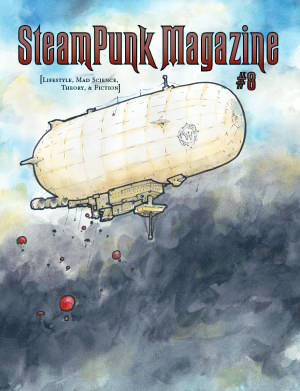Steampunk
Today, steampunk. The University of Houston's College of Engineering presents this series about the machines that make our civilization run and about the people whose ingenuity created them.
The 19th century gave us the most extraordinary technological leap forward. It began without powered vehicles, steel construction, typewriters, fast presses, airships, photography, electric lights, programmable computation ... By the end of that remarkable century we had all that. Then the 20th century added radio, electronics, TVs, airplanes ... The Victorians had thought their machines had reached a pinnacle where they might only be articulated in new ways. They had no clue that the modern era would turn their world on its ear and leave it behind.
Take Jules Verne: He made existing Victorian machinery into great submarines and dirigibles - trips to the moon or to the center of the earth. Verne books are now part of a literary genre that we call steampunk. Steampunk is a fusion of science fiction with alternate history. It expands upon 19th century technology without admitting any later ideas. People coined the term in the late 1980s. There followed a new spate of movies and books celebrating that old world of steam. Remember The Golden Compass or The League of Extraordinary Gentlemen?

Jules Verne's Nautilus Submarine as envisioned in the 1954 movie, 20,000 Leagues Under the Sea. (Pure steampunk, long before the word was invented.)
Steam had been a magic elixir pulsing through the Victorian age. So the imagined high-tech citizens of the steampunk world do calculations with steam-driven Analytical Engines -- the programmable computers Babbage proposed in the 1840s. Steam engines drive fast-moving steampunk airships. Armies might have shock troops flying over enemy lines with backpack balloons. An alternate history, shaped without the airplane, might yield a very different map of Europe. (We can actually order such maps online.)
The steampunk idea has evolved ever since the 19th century. Not long after Jules Verne, the 1927 movie Metropolis: It showed a dark steam-driven underground hell, serving idyllic Victorian comforts in the sunshine above. Even before Verne, Mary Shelley had hinted at the essence of the idea in Frankenstein. She wrote,
I saw the hideous phantasm of a man stretched out, and then, on the working of some powerful engine, ... stir with an uneasy, half vital motion.
 Her unexplained engine, of course, had to've been steam powered.
Her unexplained engine, of course, had to've been steam powered.
Any science fiction does this - envisions futures based on what's already known. It can't predict anything really new. It can suggest only futures based on what is known. Jules Verne did fairly well with 20,000 Leagues Under the Sea because submarines already existed. But his Trip to the Moon imagined technology just as silly as centuries of moon-voyage sci fi before him.
Steampunk is smarter than that. It says, "Let's embrace nostalgia. Let's predict a fictitious future where we consciously disallow new knowledge." Steampunk goes back to that glorious era of steam and rivets and asks what might've come of it if engineers and scientists had not derailed it. What if we hadn't scrambled things with our newfangled transistors, airplanes, and radio waves?
I'm John Lienhard at the University of Houston, where we're interested in the way inventive minds work.
See the Wikipedia site for more on steampunk.
An archetypical novel of the late 20th century steampunk revival is W. Gibson and B. Sterling, The Difference Engine. (Bantam Spectra, 1991). The book cover above is for the more recent book: K. McIntyre, An Airship Named Desire. (Hazardous Press, 2012).
The Mary Shelley quote is from the Author's introduction to the 1818 edition ofFrankenstein: or, The Modern Prometheus.
For an account of the texture of the huge shift from the 19th to the 20th century, see: J. H. Lienhard, Inventing Modern: Growing up with X-Rays, Skyscrapers and Tailfins. (New York, Oxford University Press): Chapters 1, 2, & 3.
For a history of the rise of the 19th century world portrayed by steampunk, see: J. H. Lienhard, How Invention Begins: Echoes of Old Voices in the Rise of New Machines. (New York, Oxford University Press): Chapters 4 through 8.

Typical Steampunk Magazine cover
This episode was first aired on July 8, 2013